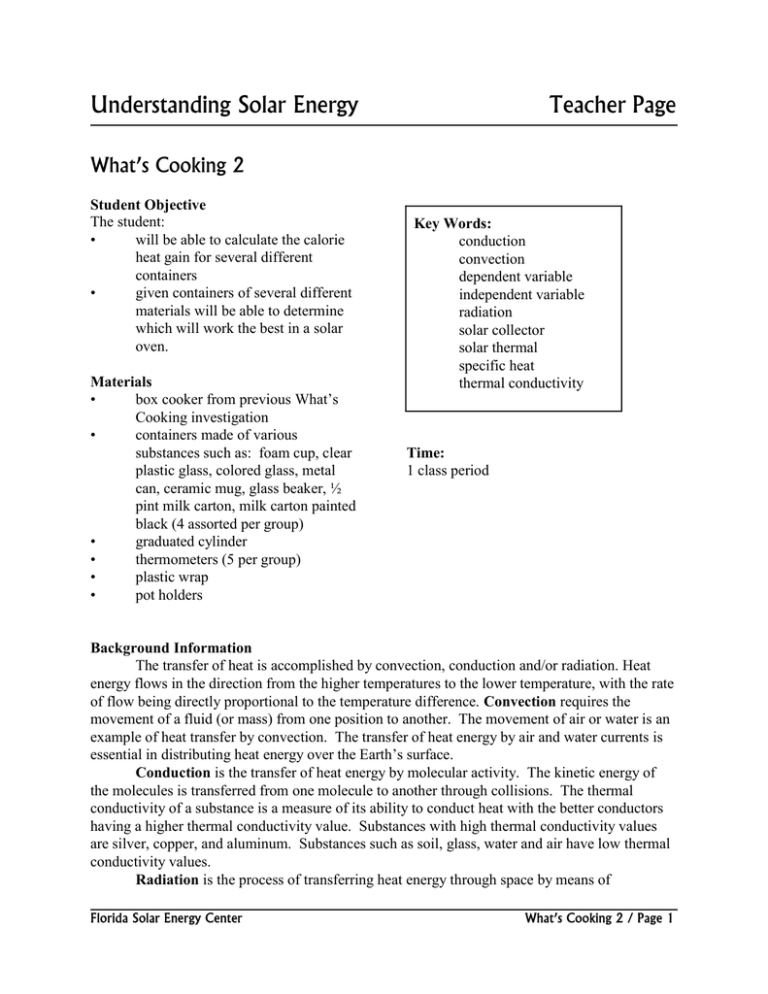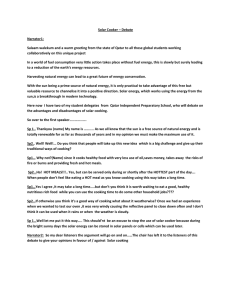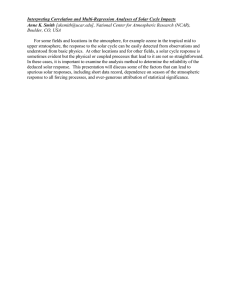Understanding Solar Energy Teacher Page What’s Cooking 2
advertisement

Understanding Solar Energy Teacher Page What’s Cooking 2 Student Objective The student: • will be able to calculate the calorie heat gain for several different containers • given containers of several different materials will be able to determine which will work the best in a solar oven. Materials • box cooker from previous What’s Cooking investigation • containers made of various substances such as: foam cup, clear plastic glass, colored glass, metal can, ceramic mug, glass beaker, ½ pint milk carton, milk carton painted black (4 assorted per group) • graduated cylinder • thermometers (5 per group) • plastic wrap • pot holders Key Words: conduction convection dependent variable independent variable radiation solar collector solar thermal specific heat thermal conductivity Time: 1 class period Background Information The transfer of heat is accomplished by convection, conduction and/or radiation. Heat energy flows in the direction from the higher temperatures to the lower temperature, with the rate of flow being directly proportional to the temperature difference. Convection requires the movement of a fluid (or mass) from one position to another. The movement of air or water is an example of heat transfer by convection. The transfer of heat energy by air and water currents is essential in distributing heat energy over the Earth’s surface. Conduction is the transfer of heat energy by molecular activity. The kinetic energy of the molecules is transferred from one molecule to another through collisions. The thermal conductivity of a substance is a measure of its ability to conduct heat with the better conductors having a higher thermal conductivity value. Substances with high thermal conductivity values are silver, copper, and aluminum. Substances such as soil, glass, water and air have low thermal conductivity values. Radiation is the process of transferring heat energy through space by means of Florida Solar Energy Center What’s Cooking 2 / Page 1 electromagnetic waves. These waves carry energy and can travel through a vacuum, such as the energy of the sun traveling through the vacuum of space to our Earth. Heat energy in the form of electromagnetic waves is both absorbed and reflected when it hits a surface. Procedure 1. Place box of various containers in the front of the room. 2. Divide students into groups of 4 - 5 students in each group. 3. Explain procedure to the class: • each group will be testing four containers for their ability to gain heat in their solar box cooker • pour 100 ml water into each container • put a thermometer in the water of each container and record the temperature in the chart in their Laboratory Manual • cover the top around the thermometer with plastic wrap and if needed, secure with rubber bands • place the cooker in the sun. Put the containers in the cooker so the thermometers will be easy to read. Place one thermometer in the oven but not in a container • record the temperature after 30 minutes (or longer if class time allows) and calculate the heat gain 4. Help students as needed during the experiment 5. Write the formula for calorie heat gain on the board Heat gain/loss = mass ( Q T ) Where Q is the specific heat gain of a substance and T is the change in temperature (positive value changes mean the temperature increased; negative values mean the temperature decreased). 6. Students should complete their Laboratory Manuals. 7. Problem set may be assigned for individual work, homework or testing. Evaluation and Student Assessment Activity and Teamwork: 50% • Are the students working cooperatively? • Are the students following activity directions? • Are the students solving problems? Lab Results and Problems: 50% • correct answers on Laboratory Manual Related Research 1. Test additional types of containers. 2. Compare class results with other classes during the day. Does the time of day make a significant difference? When is the best time to use a solar cooker? 3. Check the temperature each hour. Does the rate of heat gain change? Explain. 4. What will happen if the clear containers had a black bottom or a black outside? Florida Solar Energy Center What’s Cooking 2 / Page 2 5. 6. Investigate. What will happen if the containers were placed on a wire rack? Investigate. Will one large container reach the same temperature as fast as several smaller containers with the same total amount of water? Investigate if surface area is a variable to heat gain. Related Reading • Cooking With the Sun: How to Build and Use Solar Cookers by Beth Halacy & Dan Halacy (Morning Sun Press, 1992) Cooking With the Sun gives simple directions for solar cookers and solar hot plates along with a host of recipes including pizza, chicken and pecan pie. Internet Sites http://solarcooking.org/ Solar Cooking International, solar cooking archive includes solar cooking plans, documents and a list of resources and manufacturers. http://www.sunoven.com/ Sun Ovens International. Includes solar oven history, recipes, and photos. Florida Solar Energy Center What’s Cooking 2 / Page 3 Understanding Solar Energy Answer Key What’s Cooking 2 Answers - Laboratory Manual 1. 2. Student answers will vary. Check student math. No. The temperature of the water in a closed container will increase at a slower rate than the air in the oven due to the lower specific heat of air as compared to liquid water. Additionally, water in a closed container will not increase above 100 o C due to evaporation and condensation. 3. Answers will vary, but students should have an understanding that materials with a higher mass and/or higher specific heat values will conduct a larger amount of heat to the water 4 - 5. Student answers will vary. Check student math and unit procedures: Q = m C T where: • m = mass in kg (m for 100 ml of water = 100 g = 0.1 kg) • C = specific heat values from data table (C =4180 J / kg K for water) • T will depend on student data results ( final temperature - initial temperature) Note: changes in temperature on the Kelvin scale will equal the same change in temperature on the Celsius scale. Answers - Problems 1. 2. 3. 4. a) Al = 336,375 J b) Brass = 141,000 J c) Cu = 144, 375 J d) glass = 315,000 J e) FE = 168,750 J The container requiring the least amount of energy will heat up the fastest - Brass Brass, copper, iron, glass, aluminum Q=mC T C = Q/m T 5775 J / 1 kg (15oC) = 385 J/kg oC which is copper Florida Solar Energy Center What’s Cooking 2 / Page 4 Understanding Solar Energy Florida Sunshine Standards Benchmarks What’s Cooking 2 1 2 3 4 5 6 7 8 9 1 0 1 1 1 2 1 3 1 4 1 5 1 6 1 7 1 8 Nature of Science Standard 1 SC.912.N.1. X Physical Science Standard 10 SC.912.P.10. X X X Science Standards Standard 1: The Practice of Science • SC.912.N.1.1- Define a problem based on a specific body of knowledge, for example: biology, chemistry, physics, and earth/space science, and do the following: 1. pose questions about the natural world 2. conduct systematic observations 3. examine books and other sources of information to see what is already known 4. review what is known in light of empirical evidence 5. plan investigations 6. use tools to gather, analyze, and interpret data (this includes the use of measurement in metric and other systems, and also the generation and interpretation of graphical representations of data, including data tables and graphs) 7. pose answers, explanations, or descriptions of events 8. generate explanations that explicate or describe natural phenomena (inferences) 9. use appropriate evidence and reasoning to justify these explanations to others 10. communicate results of scientific investigations, and 11. evaluate the merits of the explanations produced by others. Standard 10: Energy • SC.912.P.10.1 - Differentiate among the various forms of energy and recognize that they can be transformed from one form to others. • SC.912.P.10.4 - Describe heat as the energy transferred by convection, conduction, and radiation, and explain the connection of heat to change in temperature or state of matter. • SC912.P.10.14 - Differentiate among conductors, semiconductors, and insulators. Florida Solar Energy Center What’s Cooking 2 / Page 5 1 9 2 0 Understanding Solar Energy Key Word/Definitions What’s Cooking 2 conduction - the movement of heat through materials by transferring kinetic energy directly from particle to particle convection - the circulatory movement or transfer of heat through fluids such as air or liquids due to differences in temperature (hotter fluids rise and cooler fluids sink). dependent variable - a condition of the experiment that is found by testing different values of the manipulated condition. The values of the dependent variable are the effects that are seen from manipulating the independent variable. independent variable - a condition of the experiment whose values are specified first or before an experiment is performed and are used to compare other values or results. Changing the values of the independent variable can be said to cause what happens to the dependent variable. radiation - the way we receive heat from the sun each day. The energy is emitted in the form of waves or photons (electromagnetic waves) and can be transferred through the vacuum of space solar collector - a device that collects and traps solar energy solar thermal - using the Sun’s energy to heat something specific heat - the amount of heat, measured in calories, required to raise the temperature of one gram of a substance by one Celsius degree thermal conductivity - the measure of a substance’s ability to conduct heat. The higher the value, the more conductive the substance. Florida Solar Energy Center What’s Cooking 2 / Page 6 Understanding Solar Energy Laboratory Manual What’s Cooking 2 1. Record your results in the data table below. Fill in the first column with the types of containers you tested. To calculate the heat gain, use the formula: Q=mC T Where: • Q = heat gain/loss • m = mass in Kg units • C = the specific heat value • T = the change in temperature Specific heat of common substances Container type Specific heat J/Kg - K air 101 aluminum 897 brass 376 copper 385 glass 840 iron 450 tin 227 water 4180 Temp (start) Temp (30 min) Calories of Heat Gain Control (air in box oven) 2. Did the water in any containers reach the same temperature as the air in the solar box Florida Solar Energy Center What’s Cooking 2 / Page 7 cooker? Why do you think this is occurred? 3. Which one of your containers increased the temperature of the water the best? What reasoning supports this result? 4. How much heat energy was absorbed in the container of water that heated up the most? Use the equation Q = m C T where C is the specific heat of water. ( Note: 100 ml of water = 100 g of water – change g to kg before solving this problem). Show your work. 5. How much heat energy from the Sun was absorbed in the air of the cooker? Use the equation Q = m C T where C is the specific heat of the air. (Note: To find the mass of the air – at the average density of 1.1 kg/m 3 for air in the temperature range of this experiment – find the approximate volume of air inside the cooker in cubic meters and multiply this value by 1.1 to get the air’s mass in kg.) Show your work. 6. Which container acted as the best conductor and the best insulator of the heat transferred by the Sun and air in the cooker? How do you know? Florida Solar Energy Center What’s Cooking 2 / Page 8 Understanding Solar Energy Problems What’s Cooking 2 For the problems below, use the formula for heat gain and the values for specific heat listed below. (Heat gain/loss) Q = mass (C) ( T ) Where C is the specific heat of a substance. Specific heat of common substances • Specific heat J/Kg - K aluminum 897 brass 376 copper 385 glass 840 iron 450 How much heat must be added to these cooking containers, each made of 5 kg of material to raise their temperatures from 25o C to 100o C? • • • • • aluminum brass copper glass iron 2. Which container from the question above would heat up faster? 3. 1 kg of 25o water is put in each container from question 1. The containers are placed in ovens that reached 125o C (and remain at that temperature for several hours). In what order would the water in the containers boil? 4. A 1 kg mass of metal absorbs 5775 J of heat when its temperature changes from 20 o C to 35o C. Calculate the specific heat of the metal. Can you identify the metal based on the specific heat values in the chart above? Florida Solar Energy Center What’s Cooking 2 / Page 9




